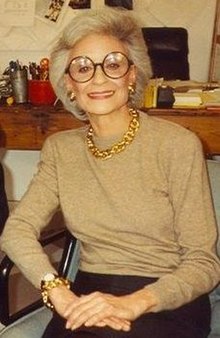This is an old revision of this page, as edited by 75.131.200.133 (talk) at 01:07, 13 July 2017. The present address (URL) is a permanent link to this revision, which may differ significantly from the current revision.
Revision as of 01:07, 13 July 2017 by 75.131.200.133 (talk)(diff) ← Previous revision | Latest revision (diff) | Newer revision → (diff)
| Frances Lear | |
|---|---|
 | |
| Born | Frances Evelyn (1923-07-14)July 14, 1923 Hudson, New York |
| Died | September 30, 1996(1996-09-30) (aged 73) Manhattan, New York |
| Occupation(s) | Activist, publisher, editor, writer |
| Known for | Lear's |
| Spouse |
Norman Lear
(m. 1956; div. 1985) |
| Children | 2 |
Frances Lear (née Evelyn, July 14, 1923 – September 30, 1996) was an American activist, magazine publisher, editor and writer. She was the wife of television producer Norman Lear from 1956–1985.
Biography
Lear was born to an unwed mother in Hudson, New York, at the Vanderheusen Home for Wayward Girls. She was adopted at 14 months by Aline and Herbert Loeb from Larchmont, New York, who changed her name from Evelyn to Frances. When she was 10 years old, her adoptive father committed suicide after losing his business in the Depression. Her mother remarried and when Frances was 12, her stepfather began molesting her, according to her autobiography. She attended the Mary A. Burnham School for Girls in Northampton, Massachusetts.
She was married and divorced twice at a young age, first to Arnold Weiss and secondly to Morton Kaufman (or Kaufmann). In 1956, she married Norman Lear in Las Vegas. At age 50, she was diagnosed with bipolar disorder. She became an activist for the women's movement, civil rights and mental health.
In 1985, she divorced Lear after 28 years of marriage. The divorce settlement, estimated to be between $100 million to $112 million, was one of the largest on record. She used $25 million of the settlement to start Lear's, a magazine targeting women over 45. She was Advertising Age Editor of the Year in 1989. The magazine folded six years later.
She was believed to be the inspiration for the character Maude Findlay on the sitcom Maude.
She published an autobiography in 1992, The Second Seduction and at the time of her death had written another book, Frances Lear's Guide to Work and Family in the 21st Century.
She had two daughters, Kate (born 1957) and Maggie (born 1959), with Norman Lear. She died of breast cancer at age 73.
References
- ^ Nemy, Enid (October 1, 1996). "Frances Lear, a Mercurial Figure of the Media and a Magazine Founder, Dead at 73". The New York Times. Retrieved April 24, 2017.
- Wolff, Geoffrey (August 1981). "Shortcuts to the Heart". Esquire. Retrieved April 24, 2017.
- Levy, Claudia; Lev (October 2, 1996). "Publisher Frances Lear Dies". The Washington Post. Retrieved April 24, 2017.
- "Frances Lear Dead at 73". Advertising Age. October 7, 1996. Retrieved April 24, 2017.
- Helmore, Edward (October 4, 1996). "Obituary: Frances Lear". The Independent. Retrieved April 24, 2017.
- "In other news". CNN. October 1, 1996. Retrieved April 24, 2017.
- Oliver, Myrna (October 1, 1996). "Frances Lear; Founder of Women's Magazine". Los Angeles Times. Retrieved April 24, 2017.
External links
- Frances Lear at IMDb
This biography of an American publisher is a stub. You can help Misplaced Pages by expanding it. |
This biographical article about an activist is a stub. You can help Misplaced Pages by expanding it. |